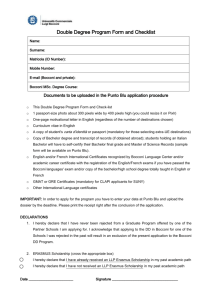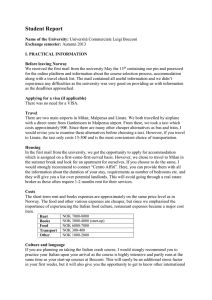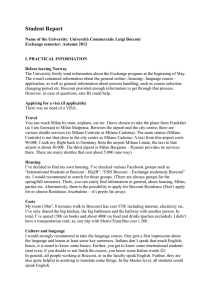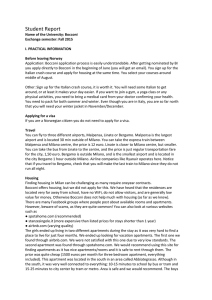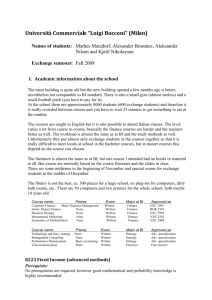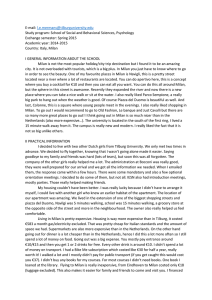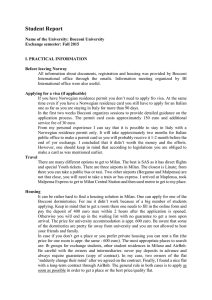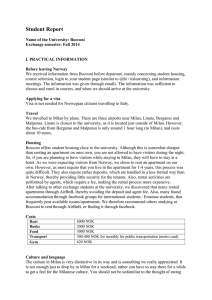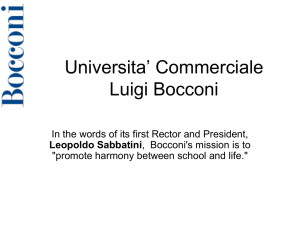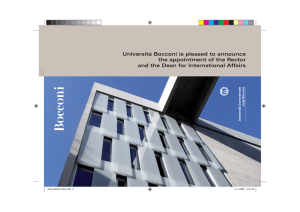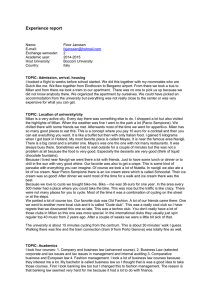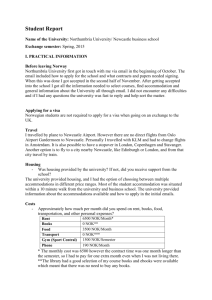Bocconi - Spring 2015 I - BI Norwegian Business School
advertisement
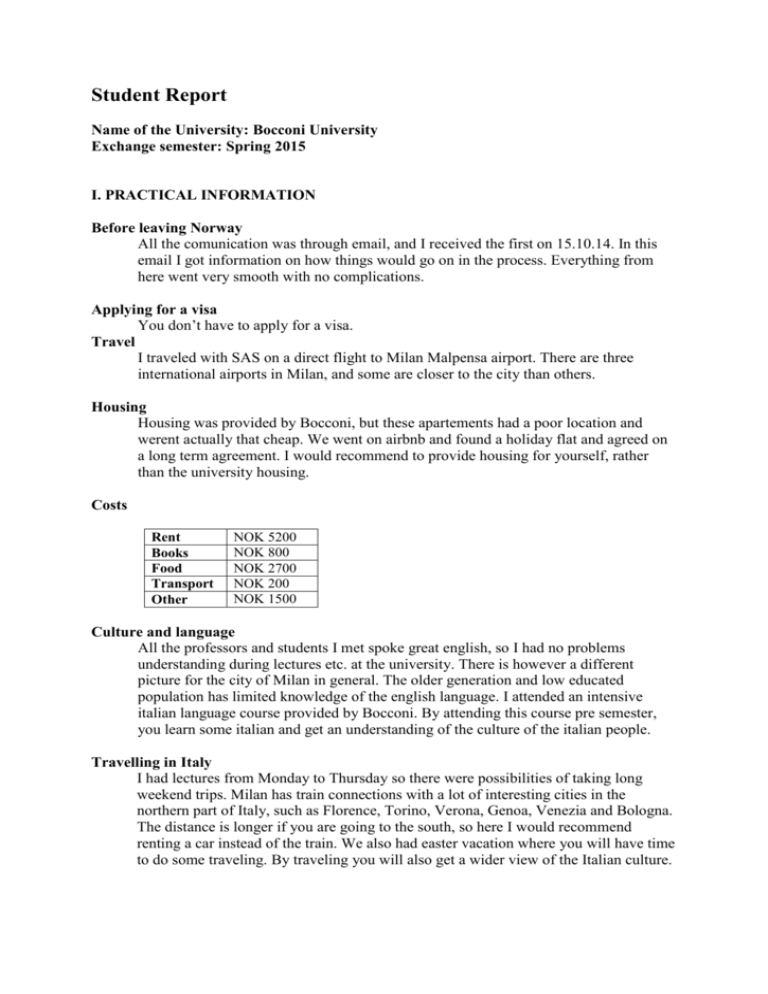
Student Report Name of the University: Bocconi University Exchange semester: Spring 2015 I. PRACTICAL INFORMATION Before leaving Norway All the comunication was through email, and I received the first on 15.10.14. In this email I got information on how things would go on in the process. Everything from here went very smooth with no complications. Applying for a visa You don’t have to apply for a visa. Travel I traveled with SAS on a direct flight to Milan Malpensa airport. There are three international airports in Milan, and some are closer to the city than others. Housing Housing was provided by Bocconi, but these apartements had a poor location and werent actually that cheap. We went on airbnb and found a holiday flat and agreed on a long term agreement. I would recommend to provide housing for yourself, rather than the university housing. Costs Rent Books Food Transport Other NOK 5200 NOK 800 NOK 2700 NOK 200 NOK 1500 Culture and language All the professors and students I met spoke great english, so I had no problems understanding during lectures etc. at the university. There is however a different picture for the city of Milan in general. The older generation and low educated population has limited knowledge of the english language. I attended an intensive italian language course provided by Bocconi. By attending this course pre semester, you learn some italian and get an understanding of the culture of the italian people. Travelling in Italy I had lectures from Monday to Thursday so there were possibilities of taking long weekend trips. Milan has train connections with a lot of interesting cities in the northern part of Italy, such as Florence, Torino, Verona, Genoa, Venezia and Bologna. The distance is longer if you are going to the south, so here I would recommend renting a car instead of the train. We also had easter vacation where you will have time to do some traveling. By traveling you will also get a wider view of the Italian culture. II. ABOUT THE SCHOOL The school Bocconi university is located south of the city centre, not too far out. Four stops with the tram and you are at Navigli. The campus consists of several buildings, two is connected, but the others are not. However, the buildings are close to each other. Transport to the university is bus or tram. Buses will be a lot fuller than we are used to in Oslo, and they are also unpredictable on schedule. Bocconi University is one of the best Business and Management schools in Europe, check different rankings. Course registration 18.12.2014 I received a student ID and pasword for the online learning platform, similar to atbi.no, called you@b. From January 8-15 2015 we registered for courses on this learning platform. Courses are assigned on a first-come-first-served basis, so you should not wait until the last day to register for courses. The add/drop period ended on February 25th. Academic calendar Arrival date: First day of the semester: Last day of classes: Examination period: Any special events/holidays: January 26th February 9th May 15th May 18th – May 29th (June 10th – June 29th) Easter Arrival The introduction week consists of an information meeting and a welcome cocktail. This is arranged by Bocconi. In addition you have an organization called ESN (Erasmus) who has a lot of social activities. They organize trips and parties in some of the best clubs in Milan. The International Office The international office at Bocconi is great! You get all the information you need, and if you have questions, you can just stop by and get an answer straight away or send an email and receive an answer some hours later. They can help you with almost anything. Social activities The ESN for exchange students organizes social events and go outs almost every day of the week, if that is desirable. You could also join the Bocconi sports team. My impression was that the italians was with italians, and exchange students was with other exchange students. The italian students were nice, but not so easy to get close to. Exchange students seemed to be more open to new relations. III. ACADEMICS In the classroom Usually there is lectures with power point presentations, but also variations with experiments, exercises, guest speakers, cases, field trips and projects. Theoretical approach with practical examples and cases for most courses. In some courses the teaching style was more practical. The classes consisted of 40-100 students, depending on the course, which opens up for more discussion during lectures. It is about the same amount of work as at BI. Course materials The course materials consisted mostly of books and powerpoints, in some cases online articles as well. Exams The exam was based on both course materials and lecture materials. You will need at least 18/30 (60%) to pass any exam or assignment. There is also two exam periods for the final exams, where you can choose if you want to take all the exams in one week in late may, or level the workload, and take some exams in june as well. If you fail on an exam in may, you can retake it in june, and still pass the course. - How was the course evaluated? o Final exam. All of my final exams were written. o Mid-term exam All of my mid-term exams were written. Only two of my courses had a mid-term exam. o Small assignments and/or papers I had to hand in a paper in one of my courses. We got the questions one week before the deadline. o Presentations Voluntary for extra grades. o Group work Some courses have group projects. o Class attendance Most courses have class attendance. You will typically need to attend at least 70% of the lectures. However, not all courses check attendence, but since the exam is based on the lectures its recommended with high attendence. o Class participation/debates Some professors use class participation for extra points on the grade. Library and technology I rarely studied at the university after lectures, this is because there is no space. The library is nice, but there is not room for a lot of students. There is a lot of rooms for group work, but these have to be booked in advance, and when you are closing up on exams they are rarely avaliable. I did all my studying other than lectures in my apartement, because you could never find an avaliable space in the library. The technology also lags far behind what you experience at BI. The printers at the university is a joke, so all the students use print shops. There is one right next to Bocconi. Course code & name Master/ Bachelor Bachelor Exam form Prerequisites 1-hour written exam + 1-hour written midterm exam Organizational Theory 30214 - Sustainable Operations Management Bachelor 45-minutes written exam (Multiple choise) None Logistics 30067 – Economic History Bachelor None Elective 30221 – Management of Fashion Companies Bachelor 30-minutes written exam + 30-minutes written midterm exam + Hand in essay 45-minutes written exam (Multiple choise + short answers) + Field Project (30% of the grade) None Elective 1-hour written exam (5 open questions) None Elective 30211 – Lean Management 30219 – Business Plan Bachelor Approved as Elective Comments Waste elimination, problem solving and value stream mapping. How to create a lean environment in a company as they have done in Toyota. Very interesting course, varied teaching style and great professor (Arnaldo Camuffo). Takes an environmental perspective to see how to make operations sustainable. A lot of reading, challenging form of exam. The course that took the most of my time. A course made for the exchange students at Bocconi. Interesting to get a look in the fashion and luxury industry. A lot of guest speakers from different fashion and luxury companies. How to start new businesses, raise capital, create new markets and so on. I took this course as a non-attending student due to overlap in my timetable. I had to read three books, and answer 5 open questions from these books. Final note A semester with new challenges. It required a lot of work, but it was all different from what I was used to at BI and I learned so much. The exchange experience allowed me to travel to new places, meet new people from all over the world, and I am really happy that I went abroad this semester, both socially and professionally.
